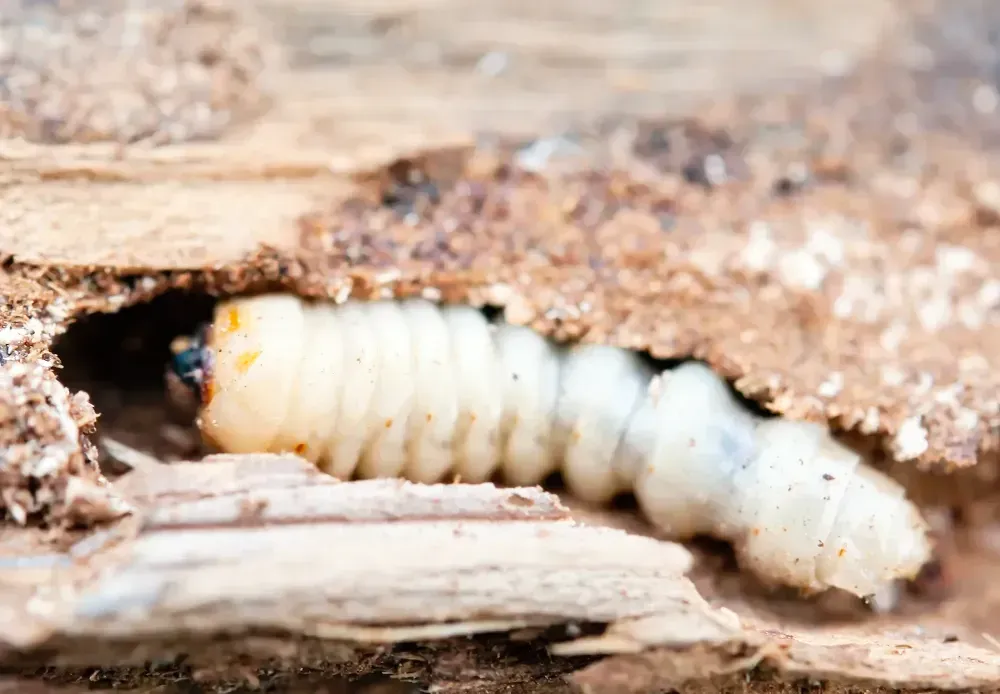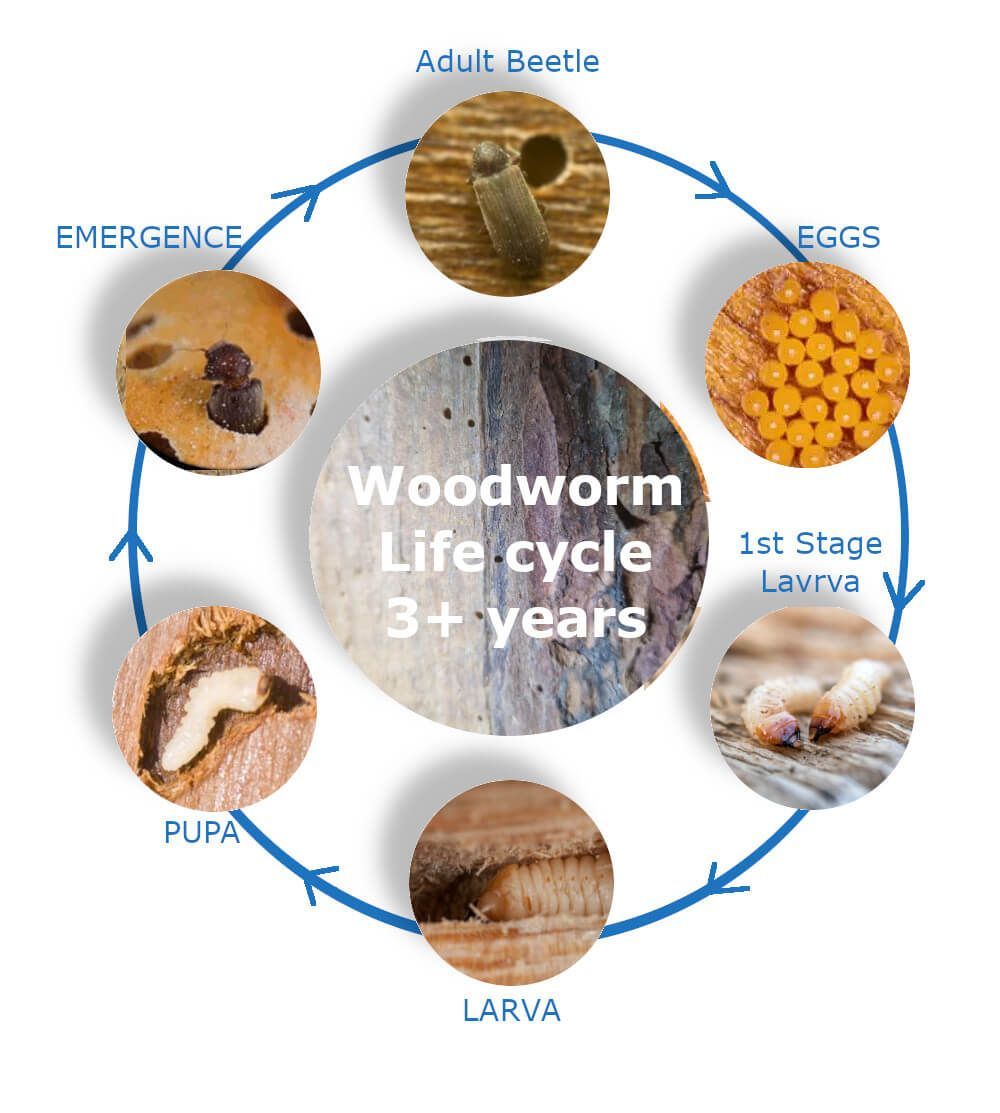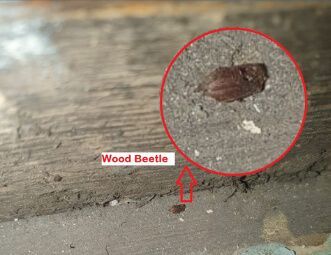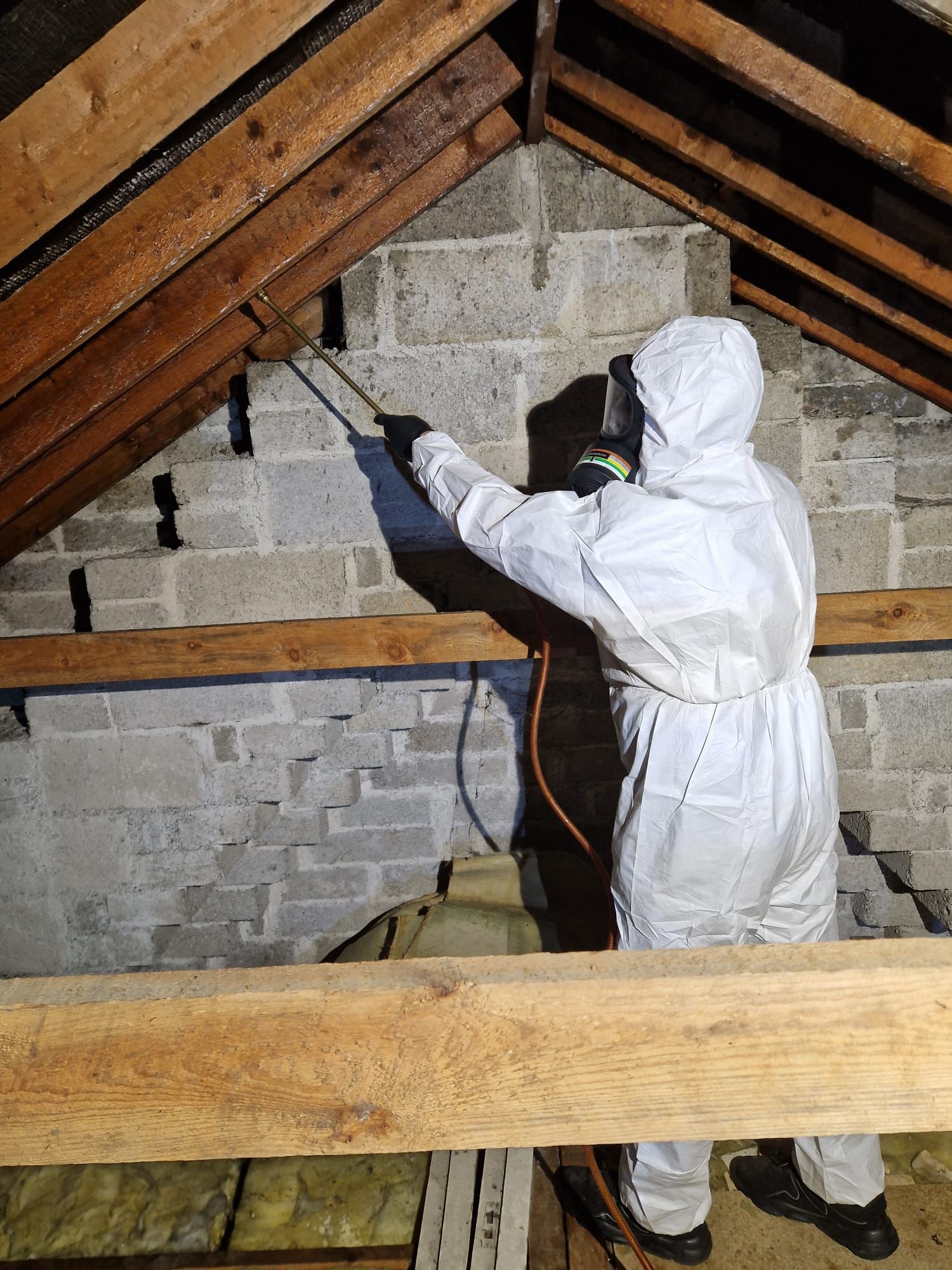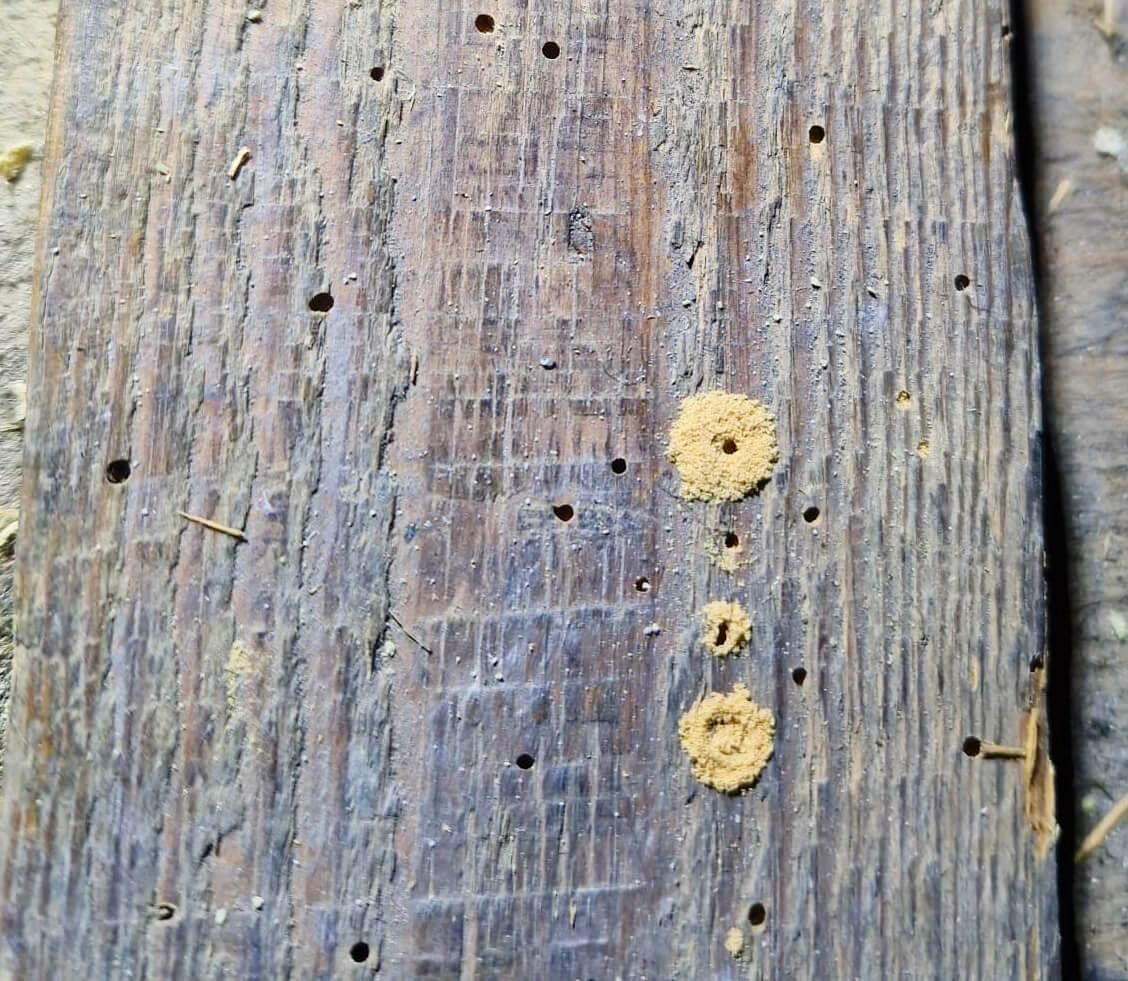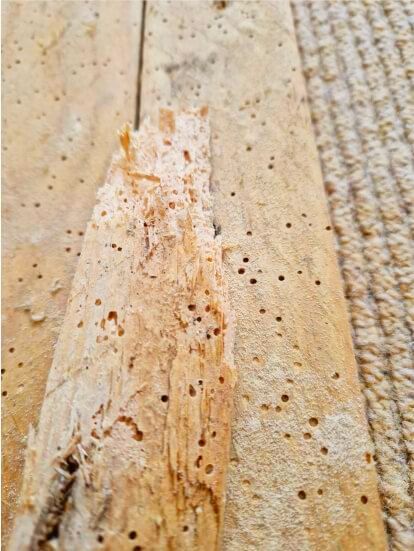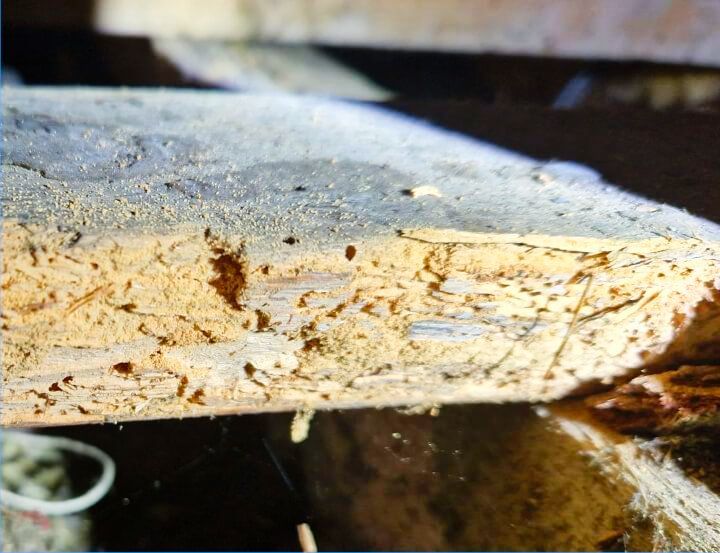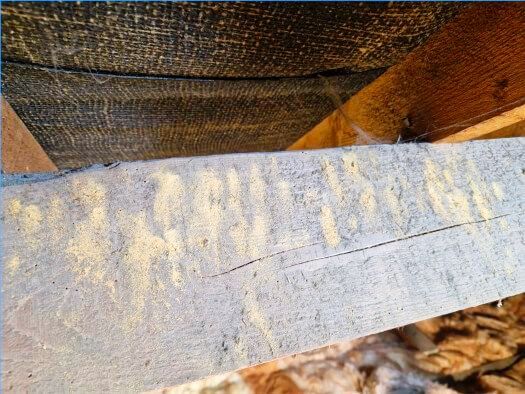What is Woodworm?
Woodworm is the general term given to the infestation of timber and wooden items by wood-boring insects. It isn’t actually a worm – in fact, they are Beetles and it’s their larvae that bore into wood, causing damage to furniture, floors and a building’s structure.
Woodworm can eventually cause serious structural damage internally and externally if they are allowed to continue their breeding cycle, and can even lead to structural collapse in a building.
Woodworm refers to the larvae of any wood-boring beetle, rather than one particular species.
In Ireland, the most common woodworms are:
- Common Furniture Beetle (Anobium punctatum)
- Deathwatch Beetle (Xestobium rufuvillosum)
- House Longhorn Beetle (Hylotrupes bajulus)
- Powderpost Beetle (Lyctus brunneus)
Life Cycle of woodworm
Woodworm eggs are barely visible to the naked eye,, They are laid in cracks and crevices or old exit holes, until the larva are formed. Woodworm larvae can be around 7mm long when fully grown. The live within timber, feeding and increasing in size as they bore. Woodworm do not live in the insulation of attic space.
Larvae bore for around 3 – 5 years, creating characteristic bore dust, before reaching their maximum size and forming a pupal chamber near the surface of the timber. This stage takes about 58 weeks before the beetles emerge.
They will than emerge and you can see the physical beetle. These beetles are usually 3 to 5mm, and emerge between May to August
Can Woodworms Bite People? No. We’ve written an article about this, if you’d like more detail, though.
How can I tell that my house has a woodworm problem?
Signs of woodworm infestation
- Burrow holes: in floorboards, timber beams, windows, door frames etc.
- Dust: white or yellowish powder can often be found around these holes.
- Damaged wood: The longer the woodworm goes untreated the more severe the damage. This can lead to structural issues in your home.
- Tunnels: When the larvae burrow into the wood it creates tunnels that weaken the structure of the wood
You’re unlikely to see a wood-boring insect – and certainly not the worm-like larvae – in your home, but you can certainly see the results – tiny holes in timber caused by the boring as the adult beetles emerge from the wood.
How did they get in?
Woodworm is often brought into the home unwittingly in second-hand furniture or reclaimed timber, the beetles can also fly into the house from outside. We can expect to see more woodworm infestations in the future due to climate change. They’re also more active in a mild autumn.
Where will you find woodworm?
Woodworm is often found in household attics, eating away at your roof beams. An unchecked woodworm infestation make their way through the timbers in your house floor by floor and can result in the weakening of timbers and the whole structure of your house. The common furniture beetle, the most common woodworm, likes damp wood and plywood. You’ll find it in damp floorboards, old furniture and attic rafters.
[ 10 Interesting Things You (Probably) Didn’t Know About Woodworm ]
If you notice any signs of woodworm in your home, call us immediately.
Our IPCA qualified technicians will:
- identify the type of insect and extent of the woodworm infestation
- determine whether the infestation is active or inactive
- check how much structural damage, if any, has occurred and advise you what needs to be done about it
- advise what woodworm treatment is best for your property
Can I treat this problem myself?
There are products that are available from DIY stores, and care should be taken when using as instructed. Woodworm is best treated by a trained professional who can guarantee you won’t have a reinfestation.
Professional Woodworm Treatment – What is involved?
There are a number of species of woodworm beetles and the precise method of treatment will depend on which species is attacking the timber. Small infestations of woodworm can be treated using a chemical insecticide which will be applied to the affected area to prevent further infestations. This is usually how furniture is treated. However, applying the treatment requires a lot of preparatory work.
All timbers must be cleaned and sanded down first or floor boards lifted and any roof insulation material will have to be removed temporarily. (It is not necessary to replace your insulation unless you wish to do so) so that you can get at the joists to work on them. Also, this avoids the fire-risk of insulation becoming impregnated with the fluid or small polystyrene granules dissolving together.
You need to cover electric cables and the cold water storage tank. Floorboards must be lifted to get at the undersides and the joists. Depending on the situation, your furniture may also have to be dismantled and treated.
Most woodworm infestations need specialised, high-pressure treatment as some types of woodworm burrow deep. They can cause extensive damage and require more than just surface spray. In those cases, to treat the wood effectively and prevent the problem from re-occurring, you need professional equipment to inject the treatment deep into the timber.
For Fast, Effective Woodworm Treatment, Call OnGuard Pest Control
Depending on the type of infestation, we offer surface spray or high-pressure treatment that penetrates deep into the wood. We treat floors, doors, door frames, beams, window frames and furniture – no stone remains unturned.
For a FREE quotation and advice – call us 01-5037787


